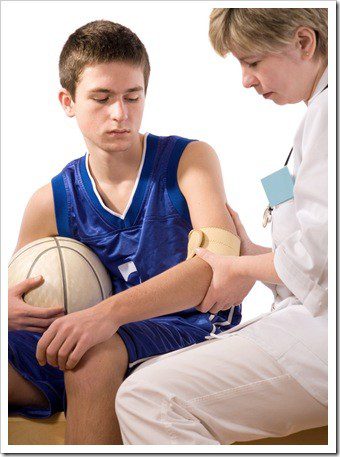
We all know that exercise and playing sports is an essential part of staying healthy. It benefits your heart, lungs, joints and bones, and also your mind in the way it releases mood-enhancing endorphins. The downside is that physical activity can sometimes lead to injury, either because we are new to it, or we push beyond our limits, or because equipment is used wrongly or is substandard, or through a simple accident. Sport injuries most commonly occur to the ankles, knees, shoulders, elbows, and spine, although the chances of getting hurt can be reduced by taking advice from your doctor of chiropractic before starting.
Strains, Sprains and Tendonitis
Broken bones can obviously occur when playing sport or exercising, but the more common injuries are those that happen to the muscles, tendons, and ligaments – the tendons attaching the muscles to the bones, and the ligaments attaching the bones to each other.
When you twist or overextend a joint, a strain can occur, which is a tear to the muscle or tendon, or a sprain can occur, which is a tear to the ligament. The damage these inflict varies in severity from a few torn or stretched fibers to a complete tear right through the structure. The latter will often require surgery to repair. Also susceptible to tearing are the intervertebral discs, which are the ligaments between the spinal vertebrae that act as shock absorbers. When this happens the disc will bulge and/or become herniated.
Overtraining is a common cause of a condition called tendonitis, which is one of the so-called “overuse syndromes”. This happens when the joint is overworked and the connecting tendons become inflamed, causing pain and dysfunction. When this happens in the shoulder, a bunch of muscles called the rotator cuff becomes inflamed and results in rotator cuff tendonitis. Perhaps the best-known form of tendonitis is “tennis elbow”, a condition replicated in “golfer’s elbow”, both named for obvious reasons.
Stress Fractures
A stress fracture, or a fatigue fracture, happens when a bone suffers too much stress. A good example would be a runner who pushes and pushes for more miles and quicker times until their system tells them enough in the form of a stress fracture. However, a novice can suffer as well if they do too much too soon. Another common runners’ injury is shin splints, where the constant foot-pounding results in microfractures on the front surface of the tibia (shin bone).
Diagnosis and Treatment
Sports injuries are usually pretty easy to diagnose because the athlete will normally have felt when something went awry. A physical examination should confirm this, but x-rays may also be ordered if the injury is suspected of being more serious, like a fracture. Injuries to the soft tissue, as in the case of tendonitis, strains and sprains, may also require deeper investigation, this time with use of Magnetic Resonance Imaging (MRI) or diagnostic ultrasound.
Plaster casts are required to treat fractures, and surgery is an option in severe cases that are not going to heal on their own. For lesser injuries, the treatment prescribed is pretty standard, as follows:
Rest
48 hours rest and/or immobilization is normally enough, unless the injury is more severe. Too much rest can work against recovery in many cases, and can even be harmful. The sooner normal function is restored, the better, provided the process is not so hurried as to cause further damage through overzealousness. Your doctor of chiropractic can advise on the optimum times for rest and recuperation.
Ice
Ice can help to reduce the inflammation and speed healing.
Compression
Swelling may be controlled somewhat through compression of the injured area, as advised by your doctor of chiropractic.
Elevation
Raising the injured limb above the level of the heart is thought to be helpful in reducing swelling.
Pain relief
According to recent research, the use of certain nonsteroidal anti-inflammatory drugs should be limited as they may in fact retard the body’s natural healing process, causing a longer recuperation than necessary.
Joint manipulation
Recent research has also shown that joint manipulation, as practiced by your doctor of chiropractic, can help with certain types of injury, lowering pain levels and speeding recovery.
Prevention
Many sports injuries are preventable through the use of proper physical conditioning, including warm-up and cool-down routines, and correct techniques when practicing the activity. It may also be the case that safety equipment is available for your particular sport or exercise which will help lower the chances of injury. Keeping hydrated with a good intake of water also guards against injuries by feeding the tissues what they most require to function optimally.
For Your Health,
Dr. Ted Smith and

